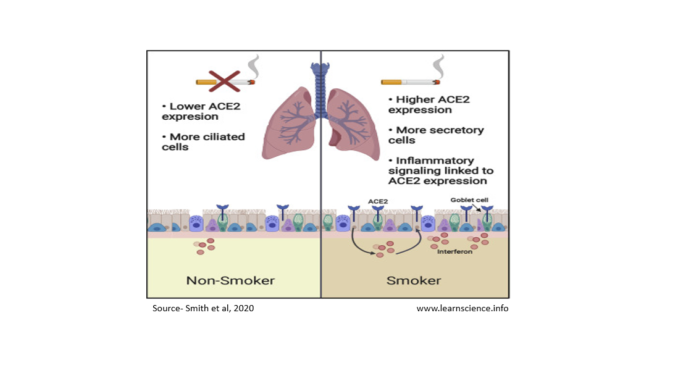
- New research results show that cigarette smoking increases the expression of Angiotensin converting enzyme-2 (ACE-2) in rodent and human lungs. ACE-2 is protein which is utilized by COVID-19 to enter human cells.
- COVID-19 is a corona virus outbreak that initially appeared in Wuhan, Hubei province, China in December 2019. As of 19 May 2020, more than 4 million people have been affected worldwide.
- From the early stages of current COVID-19 pandemic, it had been noted that people infected with SARS-CoV-2 show different response. Some individual suffers only mild illness whereas some become seriously affected and require intensive care. Mostly men, elder people and smokers are seriously affected.
- According to previous studies, smokers are twice more prone than non-smokers to suffer from infectious diseases like influenza. In the previous MERS-CoV outbreak, smokers were noted to have high mortality.
- The study found that goblet cells (mucus producing cells) are most prolific producers of ACE2 in airways. Smoking is known to increase prevalence of such cells resulting in increased ACE2 expression.
- Increased amount of goblet cells can protect the airways from the irritants but also increases vulnerability to SARS-CoV-2 infection.
- However, this change is reversible. Quitting of smoking decreases abundance of these secretory cells and reduces ACE2 levels. The level of ACE2 in the lungs of people who had quit smoking was like that of non-smokers.
References
- Smith JC, Sausville EL, Girish V, Yuan ML, Vasudevan A, John KM et al. Cigarette smoke exposure and inflammatory signaling increase the expression of the SARS-CoV-2 receptor ACE2 in the respiratory tract. Developmental Cell. 16 May 2020.
- Vardavas CI, Nikitara K. COVID-19 and smoking: A systematic review of the evidence. Tob Induc Dis. 2020; 18: 20.
- https://www.who.int/emergencies/mers-cov/en/
- https://www.who.int/ith/diseases/sars/en/